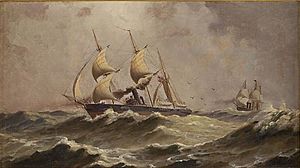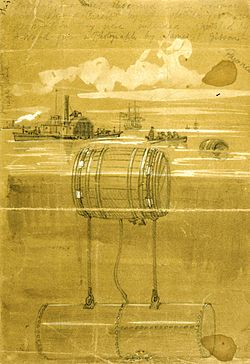Confederate States Navy facts for kids
The Navy of the Confederate States (often called the CSN) was the navy of the Confederate States of America. When the Confederacy was formed in 1861, its first president, Jefferson Davis, chose Stephen Mallory to lead the Confederate Navy.
At that time, the Southern states had almost no ships that could fight against the powerful United States Navy. They also didn't have many factories or enough raw materials to build a large navy quickly. Even with limited resources, the Confederates were very clever. They developed new technologies like naval mines (which they called torpedoes) and ironclad ships. They even managed to sink a Union warship using a working submarine!
Contents
History
The Republican Party, led by Abraham Lincoln, won the 1860 presidential election. Many Southerners were upset because Lincoln was against slavery spreading into new states and territories. After the election, seven Southern states decided to leave the United States. They declared their independence and formed the Confederate States of America, even before Lincoln became president in March 1861. The outgoing U.S. president, James Buchanan, said this was against the law but did not stop them. Lincoln and his party saw this as a rebellion.
The fighting began when the Confederates attacked Fort Sumter, a Union fort. After this, Lincoln asked for 75,000 volunteers to join the army. He also started a blockade of Southern coasts and ports. Lincoln had only about 40 warships ready, so he needed to build up his navy quickly. The blockade was meant to stop the South from selling its cotton to other countries and from buying war supplies. The North also needed to build a fleet of gunboats for a "brown-water navy" to support the Union Army on major rivers like the Mississippi.
Norfolk shipyard
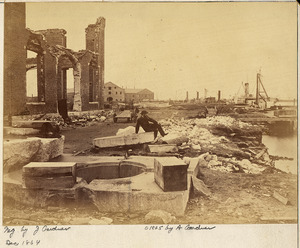
In 1861, Virginia joined the Confederacy. The Union feared the Confederates would take control of the Gosport Navy Yard (now called Norfolk Naval Shipyard). The shipyard commander, Charles Stewart McCauley, ordered it to be burned. Even though he had conflicting orders and many of his officers and workers left, his remaining men tried to destroy the shipyard. Ships that could not sail away were burned, including the Union warship USS Merrimack. However, two men trying to blow up the dry dock were captured before they could finish. This allowed the Confederates to repair Gosport and use it as their own shipyard.
Capturing the shipyard gave the Confederacy a huge amount of war materials. They took 1,195 heavy guns, which they used in many places, from Hampton Roads to Fort Donelson in Tennessee. After leaving the shipyard, Union forces moved to Fort Monroe, which was the only land in the area still under Union control.
In early 1862, the Confederate ironclad warship CSS Virginia was built using the burned hull of the USS Merrimack. The Merrimack had only been destroyed above the waterline. The Confederates built a strong armored structure over its old hull. In March and April 1862, the Virginia almost changed the course of the war. At Hampton Roads, the Virginia began sinking Union warships easily. The Union fleet was saved when their own ironclad, the USS Monitor, arrived. The two ironclads fought at the Battle of Hampton Roads for hours, but neither could defeat the other. Both sides claimed victory, but the Confederates failed to break the Union blockade. When Norfolk fell in May 1862, the crew of the CSS Virginia destroyed their ship so it wouldn't be captured. The Confederate Navy had two more ironclads being built in New Orleans, but the Union fleet captured that city before they could be finished.
Commerce raiders
The Confederate Navy knew they had fewer ships, guns, and men than the Union Navy. So, they changed their plan. First, they built forts to protect their main rivers and ports, and gunboats to help. Second, the South sent out naval ships to attack Union merchant ships at sea. They also hired privateers to help.
This idea was not new. Americans had successfully attacked British merchant ships during the American Revolutionary War. Since they were outmatched by the Union Navy, the Confederates decided to build lighter and faster cruisers. These ships could outrun larger warships and attack slower, usually unarmed, merchant ships. Because the South had few shipyards, they had these ships built in Great Britain. This was against international law because Great Britain was a neutral country. So, these ships had to be built in secret.
Some of the most famous Confederate commerce raiders were:
- CSS Florida: This was the first raider built in England. She sailed from Liverpool as the Orto and became the CSS Florida on August 17, 1862, in the Bahamas. She captured 37 merchant ships, and two of those were turned into other raiders. Together, they captured 23 more ships. The Florida was captured by the USS Wachusett in a neutral port in Bahia, Brazil, which was against international rules.
- CSS Alabama: This ship captured 65 merchant ships in 22 months. It burned 52 of them, sold 10, and turned one into another raider, the USS Tuscaloosa. It also sank a US gunboat, the USS Hatteras, which was the only Union ship lost at sea to a Confederate raider. The Alabama was sunk in a battle with the USS Kearsarge near Cherbourg, France.
- CSS Jefferson Davis: This ship was very successful, taking nine Northern merchant ships in two months. It was a 187-ton ship that used to be a slave ship. The Davis sank in a storm off St. Augustine, Florida, losing all but two of its captured ships.
- CSS Sumter: This steam cruiser was built in Philadelphia in 1859. The Confederate government bought it in New Orleans in 1861 and named it the Sumter. In six months, it captured 18 US merchant ships. Of these, it burned 8 and released or bonded 9. It was blocked by US warships in the port of Gibraltar. Many US warships took turns keeping it from leaving. It was sold on December 19, 1862, but continued to be a Confederate blockade runner renamed the Gibraltar, flying a British flag. It kept many US warships busy trying to catch it.
Privateers
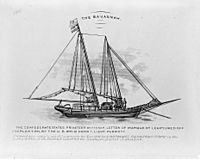
The Confederacy also gave a Letter of marque to private ship captains who wanted to make money by raiding United States merchant ships. At first, the risk was low, and they kept the ship and its cargo, much like pirates. The owner and crew shared the large profits. They usually avoided fighting Union warships and were often fast enough to escape them.
There was one problem with this plan. In 1856, the Paris Declaration Respecting Maritime Law outlawed privateering. This meant that privateers were considered pirates and could face severe punishment if captured. Even though the United States had not signed this agreement, President Lincoln declared Confederate privateers to be pirates. This did not stop some Southerners from fitting out ships to raid at sea. One of the first ships seized by a privateer actually hurt the South: it was carrying fruit to the port of New Orleans.
Soon, these privateers were taking cargo ships in the Gulf of Mexico and along the East Coast of the United States. An early Union victory was the capture of the CSS Savannah, which had only been at sea for two days. Its crew quickly faced trial for piracy. The Confederacy then threatened to punish captured Northern sailors if the Savannah crew was punished. In the end, the Union court dropped the piracy charges and held the crew as prisoners of war. The crew was later exchanged for Union prisoners.
Torpedo service
Today, a torpedo is a self-propelled, underwater explosive device. During the Civil War, what they called a torpedo was actually more like a naval mine. Confederate president Davis was against using them. He thought they were cowardly weapons and wrong to use. Despite his objections, the Congress of the Confederate States passed a law offering rewards for anyone who could invent new ways to blow up enemy ships using submersibles and mines.
In St. Louis, Missouri, Confederates hid explosives in the firewood used to fuel Union steamships on the Mississippi and Missouri Rivers. In 1861, Matthew Fontaine Maury first used mines as a weapon against enemy ships. In Virginia, his "infernal machines" made the James River almost impossible to cross.
Another invention was the coal torpedo. It looked like a lump of coal but exploded when shoveled into a ship's boiler. Another invention was called the "horological torpedo," which had a timer to delay the explosion. They also developed better fuses and more powerful explosives.
Underwater mines were used by both sides, but the Confederacy had more success. In 1862, Confederate mines sank the Union ironclad, the USS Cairo. They destroyed or damaged dozens more Union ships, while Union torpedo mines sank only about six Confederate naval ships.
Singer Secret Service Corps
The Confederate secretary of war, James Seddon, set rules that "passenger vessels of citizens of the United States on the high seas and private property on the water and [on] railroads or within the territory of the United States … not be subject of operations." But he added, "The public property of the enemy may be destroyed wherever it may be found." Seddon hired up to 25 secret agents to place torpedoes and explosives wherever they could across the Confederacy.
Known as the "Singer Secret Service Corps" or "Singer's Torpedo Company," they were a group of middle age Freemasons from many different backgrounds. They developed and used inventions like torpedo boats, underwater mines, and submarines during the last two years of the war. Some of these inventions were completely new, while others were improvements on older designs. One of their main weapons was an underwater contact mine, patented by Edgar C. Singer. It contained 50 pounds of black powder. They used up to seven different types of mines, torpedoes, torpedo boats, and submarines.
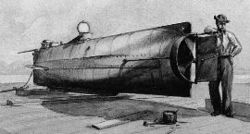
They built the submersible H. L. Hunley. This submarine destroyed the Union warship USS Housatonic by ramming it with a torpedo attached to a pole.
From their headquarters in the Spotswood Hotel in Richmond, Virginia, Singer and his agents set up secret workshops all over the South in coastal cities. During their two years of operations, they caused damage to ships, trains, and railroad bridges. Most of their missions were carried out at night, close to Union patrol boats and guards. Northern newspapers called Singer's inventions "infernal machines" and said their use was wrong. To hide what they had done, their records were burned at the end of the war. They were constantly hunted as saboteurs and spies by Northern authorities. Admiral David Dixon Porter ordered that any of Singer's agents caught with these inventions should be "shot on the spot." Names and descriptions of Singer's agents were shared by Union commanders.
One group, led by the notorious Henry Dillingham, was sent by Davis near the end of the war to occupied Kentucky and Missouri. Their goal was to destroy a key bridge and any federal transportation they could. They were known to use "coal torpedoes." Several sources suggest one was used to damage the Sultana in April 1865. This happened in the area where Dillingham was operating, and the Sultana was carrying former Confederate prisoners of war when it was damaged.
Related pages
- Confederate States Marine Corps
- Confederate States Lighthouse Bureau
- List of ships of the Confederate navy
- Blockade runners of the American Civil War
- Confederate army
- Union Navy
- United States Revenue Cutter Service
Images for kids
-
Pennant of Admiral Franklin Buchanan used at Battle of Mobile Bay, Alabama, 1864
-
Confederate naval flag, captured when General William Sherman took Savannah, Georgia, 1864
-
A 1961 painting of CSS Alabama
See also
 In Spanish: Armada de los Estados Confederados para niños
In Spanish: Armada de los Estados Confederados para niños


